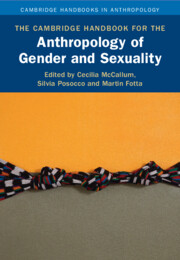Book contents
- The Cambridge Handbook for the Anthropology of Gender and Sexuality
- Cambridge Handbooks in Anthropology
- The Cambridge Handbook for the Anthropology of Gender and Sexuality
- Copyright page
- Contents
- Contributors
- 1 Introduction to The Cambridge Handbook for the Anthropology of Gender and Sexuality
- Part One Openings and Orientations
- Part Two Knowledges and Domains
- Part Three Resistances and Intersections
- Part Four Desires and Relations
- Part Five Recursivities and Futures
- 22 Ontological Sex-Genders
- 23 Futures
- Name Index
- Subject Index
- References
22 - Ontological Sex-Genders
from Part Five - Recursivities and Futures
Published online by Cambridge University Press: 29 September 2023
- The Cambridge Handbook for the Anthropology of Gender and Sexuality
- Cambridge Handbooks in Anthropology
- The Cambridge Handbook for the Anthropology of Gender and Sexuality
- Copyright page
- Contents
- Contributors
- 1 Introduction to The Cambridge Handbook for the Anthropology of Gender and Sexuality
- Part One Openings and Orientations
- Part Two Knowledges and Domains
- Part Three Resistances and Intersections
- Part Four Desires and Relations
- Part Five Recursivities and Futures
- 22 Ontological Sex-Genders
- 23 Futures
- Name Index
- Subject Index
- References
Summary
This chapter aims to trace some of the relations between anthropology and trans studies around the definition of the category “transgender.” Doubling as a category of analysis and a lived experience, the transgender category opens up long-standing conceptual, critical, and methodological tensions between trans studies and anthropology, producing aligned and yet divergent understandings of gender, representation, identity, and cultural production. Yet drawing on the connections between these disciplines, the chapter also describes how, through ethnography, both are becoming increasingly proximate, particularly as transitioning comes to be understood to fundamentally challenge deterministic models of gender experience.
- Type
- Chapter
- Information
- Publisher: Cambridge University PressPrint publication year: 2023

